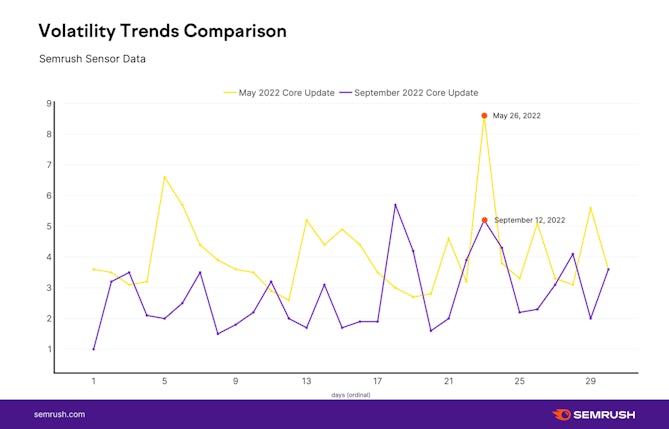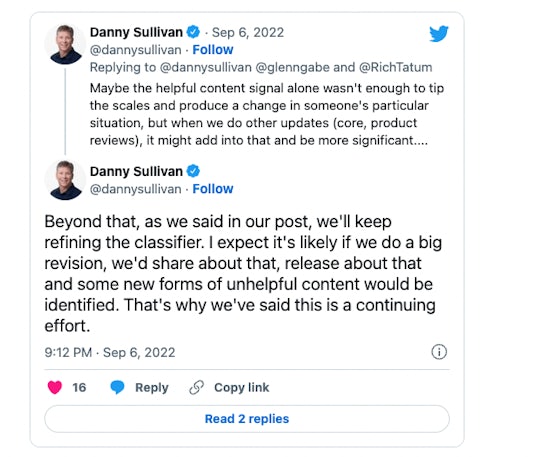September was a month of algorithm updates. From the end of the helpful content update, to a new core update and another product reviews update, we’ll cover how volatile they were and how much of an impact they’ve had. We’ll also take a look at some announcements from Google Search on 2022 event. In this post, we’ll explore:
- September core algorithm update
- Google releases September 2022 product reviews update
- A critical recap of the helpful content update
- Big announcements from Google Search on 22
The regular traffic light system is in place to highlight which algorithm updates may need immediate attention, and which ones are less pressing: red light updates are major changes that should be factored in straight away; amber is for updates that you should take note of, but won’t need urgent action; green updates are still worth knowing about, yet less critical than the others.
Keen to know more about any of these changes and what they mean for your SEO? Get in touch or visit our SEO agency page to find out how we can help.
On the 12th of September, just three days after the helpful content update finished rolling out, Google announced it was rolling out a core update – the September 2022 core update.

What was the impact of the September core update?
Initial analysis showed that search volatility spiked pretty quickly after the September update was announced, which carried on on the 13th of September, but started to dip on the 14th. However when you compare the September update volatility with that of the May core update, there’s a massive 50% drop off, as shown in the graph from SEMrush and Search Engine Journal below.

How volatile was the September core update?
The key takeaway here is that overall the September core update was much less volatile and impactful than the last two core updates, showing less pronounced and sudden spikes in volatility compared to the May core update. However due to the proximity to the helpful content update, it’s clear to some that this update is important for another reason.
Due to the close proximity of the September core update to the helpful content update, it’s going to be difficult for marketers and website owners to differentiate which update had an impact. It’s hard to imagine that it wasn’t a coincidence the two updates being so close to each other, but Danny Sullivan confirmed that sometimes it’s going to be inevitable that updates follow each other so closely.
Which industries were impacted the most?
To measure the impact of the latest update on an industry level, Semrush analysed 19 verticals against the ranking volatility of the May 2022 core update. The analysis again showed that there was little volatility in comparison to the previous core update, with Pets & Animals being impacted the most. However there’s no spike here to indicate that there was any industry in particular that was targeted by this update.

Qualifying the impact of the September core update
Overall, this core update was less impactful. To get a sense of why this is, Semrush investigated where newly ranking URLs came from if they appeared in the top 10 following the update. They found that 6.53% of the URLs now ranking in the top 10 were ranking beyond position 20 before the update. This is similar, if not less than that of the May 2022 core update.

What does this mean for me?
Of course, no matter the overall impact and volatility of the September core update, any website from any industry could’ve taken a ranking hit. SEOs and marketers on social media have remained fairly quiet regarding this update, if only to say that they’ve not seen as much volatility as they were expecting.
Given the recent downward trend in volatility with more recent updates, we should expect to not see too many major changes in ranking until the next core update. However due to the recent volatile environment we’ve been in, with three generous updates at once (Helpful content, September core and product review updates), we can hope that there’ll be a lull in updates for a while.
In particular with this update, Google has placed emphasis on more helpful, quality content, so a good way to diminish any potential ranking disruption would be to create and optimise people-first content that utilises best SEO practices.
If your site has been negatively affected by the September core update, take a look at our guide to recovering from an algorithm update for a step-by-step guide on actioning change.
The Google product reviews update was released on September 20th, this came seemingly early as the last product review update was rolled out in July. This is the fifth update in this series and is targeted at ranking product review rated content on the web.
What to watch out for
These updates typically take a few weeks to complete but you can expect the majority of ranking volatility to be present in the early stages of the rollout.
What’s the impact
As of now the update is currently only focussed on English product reviews but Google said that in future it will be implemented across product reviews in all languages.
Google recommended that “focus overall is on providing users with content that provides insightful analysis and original research, content written by experts or enthusiasts who know the topic well,”.
Google’s helpful content finished rolling out September 9th, the impact was only affected in a few website categories such as ringtone, coding and lyrics pages. Its impact was small in comparison to Google’s previous updates.
Observations and reflections between theory and practice of the helpful content update
| ‘Focus on people-first content‘ |
| Observation | Reflection |
|---|---|
| This update should affect the content of entire websites, not just individual pieces of content. | A website-wide penalty can be assumed if you look at the strong loss of visibility for the few domains, that are supposedly negatively affected by the update. |
| Google wants to devalue automated content in order to combat the flood of AI-generated content. | This doesn’t make complete sense when AI tools aren’t used to generate text for ring tones, coding and lyrics. |
Another theory is that the helpful content update is essential to the ranking algorithms, and the effects can only be seen over a long time, possibly even years, similarly to the Hummingbird update.
Danny Sullivan (Google’s Search Liaison) hinted there may be further updates to refine the update:

When referring to the criteria for Google’s helpful content update:
- The classifier process is automated, using a machine learning model
- It’s got a new signal and one of many to rank content, meaning that people-first content sites classified as having unhelpful content can still rank well (if there are signals that identify people-first content).
The helpful content update was a well-established PR campaign
The new update name is similar to “Page Experience” whilst different from the core updates, Hummingbird, Panda, or Penguin. The new update explains explicitly what it’s about, which should make PR messaging more effective. The overall message that Google is trying to communicate with this update is that they are constantly working to make their search engine more helpful for users.
Google gave specific recommendations for the update on what webmasters should do, which is different from most previous updates. This shows that the supposed PR campaign was also aimed at website operators, not just the SEO industry.
The main focus of the SEO industry and media for the past two weeks has been Google’s helpful content update. This update has made searches more helpful, and has been widely reported on.
A lasting thought for the SEO industry
The Google helpful content update is a prime example of a professionally conducted product PR campaign from which you can learn a lot.
For us SEOs, the realisation remains that we are important stakeholders for Google for the passing on their company messages.
Here, Google shows a shift in PR and communication strategies from recent years and seeks proximity to influential personalities from the SEO industry.
At the Google Search On 22 event there were a number of announcements relating to new Google search features. Here is our select pick of those that are most interesting and relevant.
Google Multisearch is expanding
Last year Google released multisearch, giving users the ability to search using their camera with the ability to add a query in the search bar to get them a relevant SERP. This originally only operated on UK & US based queries but will be expanding to 70 new languages in the coming months.
Multisearch near me will also be coming soon allowing for these searches to include local results for example if you’re looking for a physical store that sells a particular item of clothing near you.
Search Refinements
Now when inputting a query into the Google search bar you will be presented with various tappable autocomplete options to help build your query. You will also be able to refine your query with the ability to add or remove topics from your query after you search, creating a more dynamic top search bar. This will likely help Google to understand what users are looking for when it comes to searches that show a mixed SERP e.g. the query “living room” displays pages for inspiration, images and category pages.


More visual search experience
This visual approach will be mainly aimed at topics related to travel, animals, plants and anything else that can be enriched with short videos, tips and stories. This is inline with the current trend brought about by TikTok and other social media. However this more visual experience does seemingly seek to stop users clicking through to a website as more and more information will be presented in these rich results.

Keep up-to-date with our dedicated algorithm and search industry round-ups. For any further information about these posts – or to learn how we can support your SEO – get in touch today.








